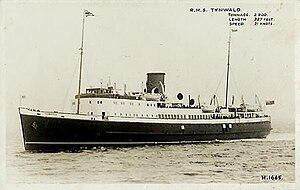| SS Tynwald (1936) | |
|---|---|
 RMS Tynwald | |
| Career (Isle of Man) | |
| Name: | Tynwald |
| Owner: | 1936–1940: Isle of Man Steam Packet Company |
| Operator: | Isle of Man Steam Packet Company |
| Port of registry: |
|
| Ordered: | 1936 |
| Builder: | Vickers-Armstrong, Barrow-in-Furness, United Kingdom |
| Laid down: | 1935 |
| Launched: | 16 December 1936 |
| Completed: | 1937 |
| In service: | 1937 |
| Out of service: | Transferred to the Royal Navy as HMS Tynwald, late 1940 |
| Homeport: | Douglas, Isle of Man |
| Identification: |
Official Number 165281 Code Letters G Z R L |
| Career (Royal Navy) | |
| Name: | HMS Tynwald |
| Commissioned: | 1 October 1941 |
| Fate: | Sunk on 12 November 1942 |
| Status: | War Grave |
| General characteristics | |
| Type: | Passenger steamer |
| Tonnage: | 2,375.53 GRT |
| Length: | 314 ft 6 in (95.9 m) |
| Beam: | 46 ft (14.0 m) |
| Depth: | 18 ft (5.5 m) |
| Installed power: | 8,500 shp (6,300 kW) |
| Propulsion: | Twin-screw geared turbines, working at a steam pressure of 250 pounds per square inch (1,700 kPa), driving two sets of single-reduction turbines, developing 8,500 shp (6,300 kW) |
| Speed: | 21.7 knots (25.0 mph) |
| Capacity: | 1968 passengers |
| Crew: | 68 |
TSS (RMS) Tynwald No. 165281 was a passenger vessel which served with the Isle of Man Steam Packet Company from 1937 until she was requisitioned for war service at the end of 1940, — the fourth ship in the line's history to bear the name. She was sunk in late 1942 by either a mine or a torpedo.

Tynwald is launched at Barrow-in-Furness, December 16, 1936.
Design and construction[]
Tynwald and her identical twin Fenella (II) were both built by Vickers Armstrong at Barrow-in-Furness, and both were launched on the same day, 16 December 1936.
Tynwald had a gross registered tonnage of 2376t, a beam of 46', a length of 314'6", a draught of 18' and a design speed of 21 knots. Both Tynwald and her sister Fenella, had crew accommodation for 68, and a capacity for 1968 passengers.
Steam Packet Company service[]

Tynwald in pre-war passenger service, pictured leaving Belfast.
Like her sister ship Fenella, Tynwald was intended primarily to be used on the winter service between Liverpool and Douglas.
War service[]
Along with Fenella, Tynwald was requisitioned as a personnel vessel in the first week of the war. Her log was largely uneventful until with the German onslaught during the spring of 1940, the plight of the British Expeditionary Force became all too apparent, and she was despatched to assist with the evacuation of troops from Dunkirk.
During the course of Operation Dynamo, Tynwald, initially under the command of Captain J H Whiteway, and then under Captain W A Qualtrough, had the distinction of embarking more troops that any other company vessel.[1]
She made her first mission to the shattered port on 28 May, and was one of ten personnel ships that lifted a total of 14,760 troops from the East Pier the following day. The same day, her sister Fenella was lost.
In the late evening of 30 May, she was one of four personnel vessels back at the pier and withdrew 1,153 troops. On 2 June, she made her third trip and embarked 1,200 troops, leaving for Dover in the early morning of 3 June.
The last day of the operation was 4 June; shortly after 14:00hrs, the Admiralty announced that Operation Dynamo was over. By then Tynwald had already left the East Pier after her fourth trip. She was the last ship to leave, and landed 3,000 French troops in England later that day. Her total in the operation is officially given as 8,953 troops.
[]
At the end of 1940, she was compulsorily acquired, fitted out as an auxiliary anti-aircraft ship and commissioned as HMS Tynwald on 1 October 1941. After a year on convoy escort duties around Britain she was assigned to Operation Torch, the allied landing in North Africa, and was involved in the attack on Algiers on 8 November 1942.

HMS Tynwald in naval service
Three days later the ship was part of a task force sent to capture an airfield near Bougie (modern Béjaïa) 100 miles east of Algiers. At the centre of the force were infantry landing craft, and the covering force included the cruiser HMS Sheffield, the monitor HMS Roberts, Tynwald and fourteen other supporting vessels. The first landing met with little or no opposition, and the Bougie harbour was occupied. However, it proved impossible to capture the airfield from the sea owing to the adverse weather conditions. Instead, the attacking force that was still at sea came under heavy enemy air attack.
Fate[]
On 12 November, Tynwald was hit by a torpedo fired by the Italian submarine, Argo.[2] She had been standing by the monitor Roberts, which was on fire and badly damaged. Tynwald went down in 7 fathoms (13 m) of water,[3] her wreck position is given as LAT:36°51'N LON:005°04'E.[4]
Three officers and seven ratings were listed as casualties.
Footnotes[]
- ↑ "Manx Lifeline". Kneen Family. http://www.kneen.com/Manx%20life%20line.htm. Retrieved 2013-08-04.
- ↑ "Regia Marina Italiana". Cristiano D'Adamo. http://www.regiamarina.net/detail_text_with_list.asp?nid=84&lid=1&cid=4. Retrieved 2012-08-10.
- ↑ "HMS Tynwald - anti-aircraft ship". U-Boat.net. http://www.uboat.net/allies/warships/ship/12307.html.
- ↑ http://www.wrecksite.eu/wreck.aspx?96366
The original article can be found at SS Tynwald (1936) and the edit history here.